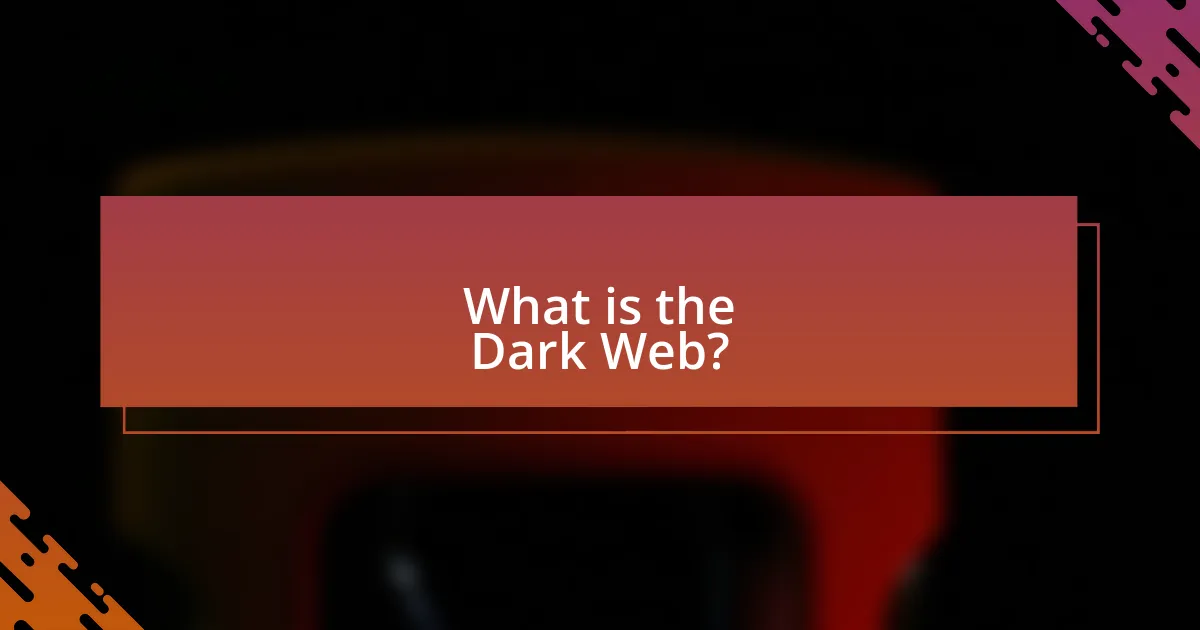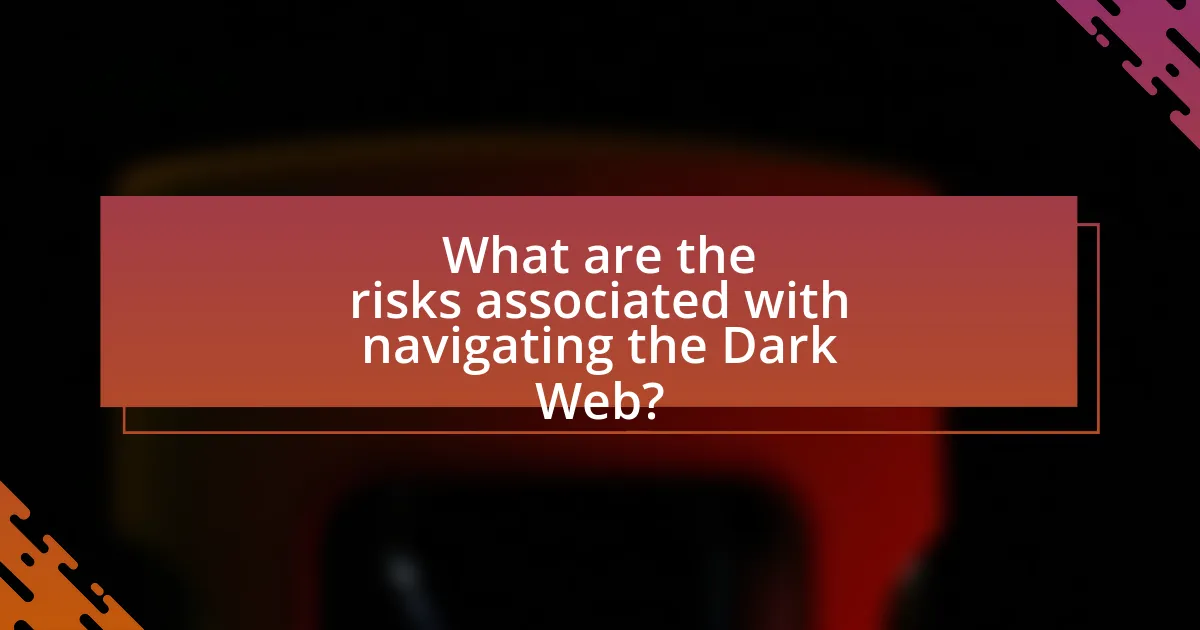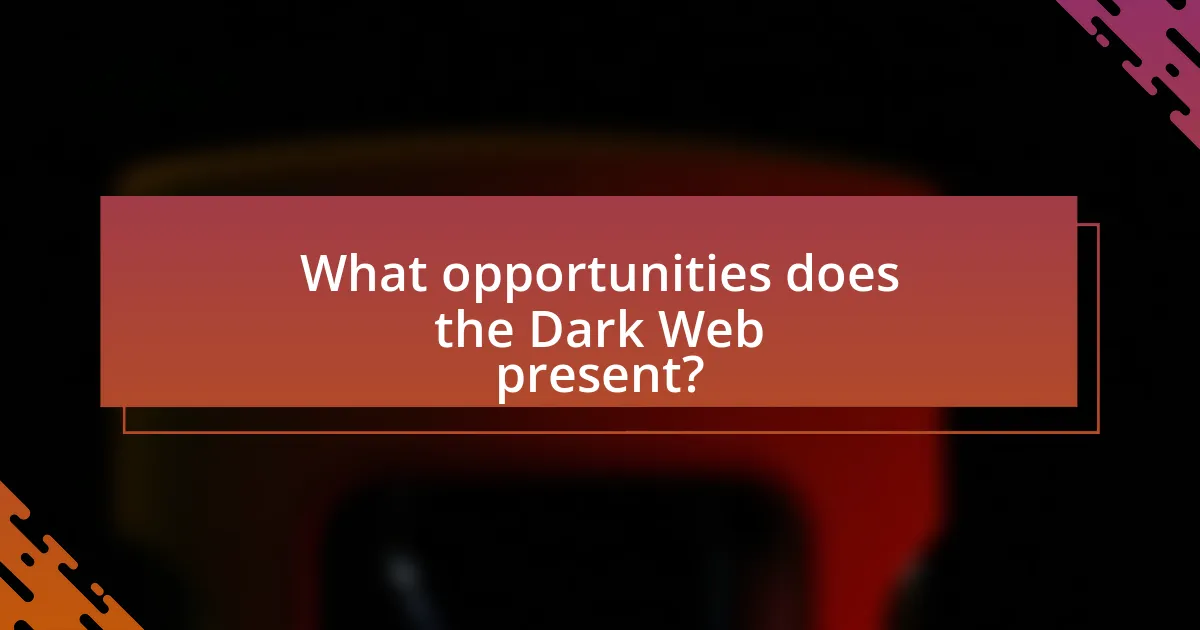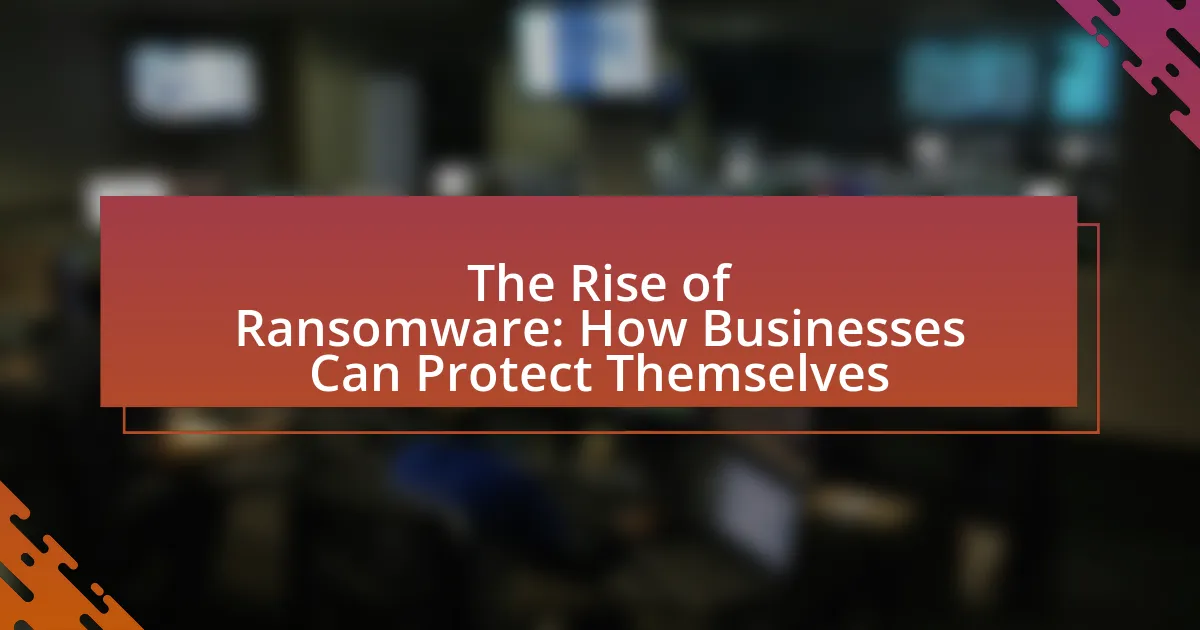The Dark Web is a segment of the internet that requires specialized software, such as Tor, for access and is not indexed by traditional search engines. It is characterized by a dual nature, hosting both illicit activities—such as drug trafficking and the sale of stolen data—and legitimate uses, including privacy protection and secure communication for activists and whistleblowers. This article explores the differences between the Dark Web and the Surface Web, the risks associated with navigating the Dark Web, common misconceptions, and the opportunities it presents for privacy and freedom of expression. Additionally, it discusses the legal consequences of engaging in illegal activities, security threats users may face, and best practices for safe navigation.

What is the Dark Web?
The Dark Web is a part of the internet that is not indexed by traditional search engines and requires specific software, such as Tor, to access. It is often associated with illegal activities, including the sale of drugs, weapons, and stolen data, but it also serves as a platform for privacy-focused communication and information sharing. According to a 2020 report by the European Union Agency for Cybersecurity, approximately 57% of the content on the Dark Web is illicit, highlighting its dual nature as both a haven for criminal activity and a space for anonymity.
How does the Dark Web differ from the Surface Web?
The Dark Web differs from the Surface Web primarily in accessibility and content. The Surface Web is the portion of the internet that is indexed by search engines and accessible to the general public, comprising about 90% of the internet. In contrast, the Dark Web consists of encrypted networks that require specific software, such as Tor, to access, making it less visible and often associated with illegal activities. Research indicates that while the Surface Web hosts legitimate websites, the Dark Web is known for hosting illicit marketplaces, forums, and services that facilitate criminal behavior, highlighting a stark contrast in the nature of content available on both platforms.
What are the key characteristics of the Dark Web?
The key characteristics of the Dark Web include anonymity, specialized access, and illicit activities. Anonymity is achieved through technologies like Tor, which masks users’ identities and locations, making it difficult to trace online activities. Specialized access is required to enter Dark Web sites, as they often use unique domain extensions such as .onion, which are not accessible through standard web browsers. Additionally, the Dark Web is known for hosting a range of illicit activities, including the sale of illegal drugs, weapons, and stolen data, as well as forums for hacking and other criminal enterprises. According to a 2017 report by the European Union Agency for Cybersecurity, approximately 57% of Dark Web content is associated with illegal activities, highlighting its reputation as a hub for criminal behavior.
Why is anonymity important in the Dark Web?
Anonymity is crucial in the Dark Web because it protects users from surveillance and potential legal repercussions. The Dark Web often hosts illegal activities, such as drug trafficking and hacking, making anonymity essential for individuals seeking to engage in these activities without facing law enforcement. Research indicates that platforms like Tor, which facilitate anonymous browsing, are specifically designed to obscure user identities, thereby enabling freedom of expression and privacy in oppressive regimes. This anonymity is supported by the fact that many users rely on it to share sensitive information or whistleblow without fear of retaliation.
What are the common misconceptions about the Dark Web?
Common misconceptions about the Dark Web include the belief that it is solely a hub for illegal activities and that it is entirely anonymous. While the Dark Web does host illegal marketplaces, it also serves legitimate purposes, such as providing a platform for free speech in oppressive regimes. Additionally, while users can achieve a degree of anonymity, complete anonymity is not guaranteed due to potential tracking methods and vulnerabilities in software like Tor. These misconceptions often stem from sensationalized media portrayals and a lack of understanding of the Dark Web’s complexities.
How do these misconceptions affect public perception?
Misconceptions about the dark web significantly skew public perception, often leading to an exaggerated fear of its dangers. For instance, many individuals believe that the dark web is solely a hub for illegal activities, which oversimplifies its complexity and overlooks its legitimate uses, such as privacy protection and whistleblowing. This narrow view can result in a lack of understanding about the potential benefits of the dark web, such as fostering free speech in oppressive regimes. Research indicates that 70% of people associate the dark web exclusively with criminality, which can hinder informed discussions about internet privacy and security. Consequently, these misconceptions can perpetuate stigma and misinformation, ultimately shaping public policy and individual behavior in ways that may not reflect the true nature of the dark web.
What truths counter these misconceptions?
The truth that counters misconceptions about the dark web is that it is not solely a hub for illegal activities; it also serves legitimate purposes, such as privacy protection and free speech. Research from the Electronic Frontier Foundation highlights that individuals in oppressive regimes use the dark web to communicate securely and access information without censorship. Additionally, while the dark web does host illegal marketplaces, studies indicate that a significant portion of its content is dedicated to forums, educational resources, and privacy-focused services. This duality illustrates that the dark web encompasses both risks and opportunities, challenging the oversimplified view of it as merely a criminal underworld.

What are the risks associated with navigating the Dark Web?
Navigating the Dark Web poses several significant risks, including exposure to illegal activities, cybersecurity threats, and potential legal consequences. Users may inadvertently engage with illicit marketplaces that facilitate the sale of drugs, weapons, and stolen data, which can lead to criminal charges. Additionally, the Dark Web is rife with malware and phishing schemes that can compromise personal information and financial security. According to a report by the Cybersecurity and Infrastructure Security Agency (CISA), users are at heightened risk of identity theft and financial fraud when accessing unregulated sites. Furthermore, law enforcement agencies actively monitor Dark Web activities, increasing the likelihood of legal repercussions for users involved in illegal transactions.
What types of illegal activities are prevalent on the Dark Web?
The Dark Web is known for various prevalent illegal activities, including the sale of drugs, weapons trafficking, and the exchange of stolen data. Drug trafficking is particularly significant, with marketplaces like Silk Road historically facilitating the trade of illegal substances. Weapons sales are also common, often involving firearms and explosives, while stolen data, including credit card information and personal identities, is frequently bought and sold, contributing to identity theft and fraud. According to a 2020 report by the European Union Agency for Law Enforcement Cooperation (Europol), these activities represent a substantial portion of the Dark Web’s economy, highlighting the ongoing challenges law enforcement faces in combating these crimes.
How do these activities impact users and society?
Activities on the dark web significantly impact users and society by facilitating both illicit and legitimate exchanges. Users may engage in illegal activities such as drug trafficking, weapon sales, and identity theft, which contribute to crime rates and societal instability. For instance, a report by the European Monitoring Centre for Drugs and Drug Addiction indicates that the dark web is a growing marketplace for illegal drugs, with over 30% of online drug sales occurring through these platforms. Conversely, the dark web also provides a space for whistleblowers and activists to communicate securely, promoting free speech and privacy in oppressive regimes. This duality illustrates how dark web activities can simultaneously pose risks and offer opportunities for societal change.
What are the legal consequences of engaging in these activities?
Engaging in activities on the dark web can lead to severe legal consequences, including criminal charges, fines, and imprisonment. Law enforcement agencies actively monitor dark web activities, and individuals involved in illegal transactions, such as drug trafficking or the sale of stolen data, can face prosecution under various laws, including the Controlled Substances Act and the Computer Fraud and Abuse Act. For instance, in 2019, the FBI arrested individuals involved in dark web drug sales, resulting in sentences ranging from several years to life in prison, demonstrating the serious repercussions of such actions.
What security threats should users be aware of?
Users should be aware of several security threats when navigating the dark web, including malware, phishing attacks, and identity theft. Malware can be encountered through malicious downloads or compromised websites, leading to data breaches or system damage. Phishing attacks often occur via deceptive emails or messages that trick users into revealing personal information. Identity theft is a significant risk, as personal data can be bought and sold on the dark web, leading to unauthorized access to financial accounts or other sensitive information. According to a report by Cybersecurity Ventures, cybercrime is projected to cost the world $10.5 trillion annually by 2025, highlighting the severity of these threats.
How can malware and hacking incidents occur on the Dark Web?
Malware and hacking incidents can occur on the Dark Web through the distribution of malicious software and the exploitation of vulnerabilities in systems. Cybercriminals utilize the anonymity provided by the Dark Web to sell and share malware, which can be used to compromise personal and organizational data. For instance, a report by the cybersecurity firm McAfee indicates that the Dark Web hosts numerous forums where hackers exchange tools and techniques for executing cyberattacks, including ransomware and phishing schemes. Additionally, the lack of regulation and oversight on the Dark Web facilitates the proliferation of these malicious activities, making it a hotspot for cybercriminals seeking to exploit unsuspecting users.
What measures can users take to protect themselves?
Users can protect themselves by employing a combination of strong cybersecurity practices. Utilizing a virtual private network (VPN) encrypts internet traffic, making it difficult for third parties to monitor online activities. Additionally, using strong, unique passwords for different accounts and enabling two-factor authentication significantly reduces the risk of unauthorized access. Regularly updating software and operating systems ensures that users benefit from the latest security patches, which protect against vulnerabilities. Furthermore, being cautious about sharing personal information and avoiding suspicious links or downloads can prevent malware infections and data breaches. According to a report by Cybersecurity Ventures, cybercrime is projected to cost the world $10.5 trillion annually by 2025, highlighting the importance of these protective measures.

What opportunities does the Dark Web present?
The Dark Web presents opportunities for anonymity, privacy, and access to information not available on the surface web. Individuals can engage in secure communications, share sensitive information, and access forums that discuss topics like privacy rights, political dissent, and whistleblowing. For example, journalists and activists use the Dark Web to communicate securely and protect their identities from oppressive regimes. Additionally, the Dark Web offers marketplaces for legal goods and services that may be restricted in certain regions, allowing users to bypass censorship. These opportunities highlight the potential for both positive and negative uses of the Dark Web, emphasizing its dual nature as a tool for freedom and a platform for illicit activities.
How can the Dark Web be used for privacy and freedom of expression?
The Dark Web can be used for privacy and freedom of expression by providing a platform where individuals can communicate and share information anonymously. This anonymity is crucial for activists, journalists, and whistleblowers who may face persecution or censorship in their home countries. For instance, the use of Tor, a popular Dark Web browser, allows users to access websites without revealing their IP addresses, thereby protecting their identities. According to a report by the Electronic Frontier Foundation, this level of privacy enables users to discuss sensitive topics freely, fostering open dialogue in oppressive regimes. Additionally, the Dark Web hosts forums and platforms that support free speech, allowing marginalized voices to be heard without fear of retribution.
What role does the Dark Web play in oppressive regimes?
The Dark Web serves as a crucial platform for communication and information exchange in oppressive regimes. It enables dissidents and activists to bypass government censorship and surveillance, facilitating the sharing of ideas and organizing protests. For instance, during the Arab Spring, activists utilized the Dark Web to coordinate actions and disseminate information despite state-imposed restrictions. Additionally, the anonymity provided by the Dark Web protects users from government reprisals, allowing them to express dissent without fear of persecution. This role underscores the Dark Web’s significance as a tool for resistance against authoritarian control.
How can whistleblowers and activists benefit from the Dark Web?
Whistleblowers and activists can benefit from the Dark Web by utilizing its anonymity to share sensitive information without fear of retaliation. The Dark Web provides encrypted communication channels that protect the identities of individuals disclosing classified or controversial information, allowing them to expose corruption or human rights abuses securely. For instance, platforms like SecureDrop enable whistleblowers to submit documents to journalists while maintaining their anonymity, which has been crucial in high-profile cases such as the Panama Papers. This level of security encourages more individuals to come forward with vital information that could lead to significant societal changes.
What are the potential business opportunities on the Dark Web?
Potential business opportunities on the Dark Web include the sale of privacy-focused products, such as VPN services and encrypted communication tools, as well as digital goods like counterfeit items and hacking services. The Dark Web’s anonymity attracts users seeking to bypass regulations, creating a market for illicit services and products. For example, the global market for illicit drugs on the Dark Web was estimated to be worth over $300 million annually, according to a 2019 report by the European Monitoring Centre for Drugs and Drug Addiction. Additionally, cybersecurity firms can find opportunities in providing solutions to combat the threats posed by Dark Web activities, as the demand for protection against data breaches and cybercrime continues to grow.
How can businesses leverage the Dark Web for market research?
Businesses can leverage the Dark Web for market research by analyzing trends, consumer sentiments, and competitor activities that are not available on the surface web. By accessing forums, marketplaces, and chat rooms, companies can gather insights on emerging products, pricing strategies, and customer feedback. Research indicates that 60% of data breaches originate from the Dark Web, highlighting the importance of monitoring this space for potential threats and opportunities. Additionally, tools like Dark Web monitoring services can help businesses track mentions of their brand or industry, providing valuable intelligence that can inform strategic decisions.
What ethical considerations should businesses keep in mind?
Businesses should prioritize transparency, data privacy, and compliance with legal standards when navigating the dark web. Transparency ensures that stakeholders are informed about the risks and practices associated with dark web activities. Data privacy is crucial, as businesses must protect sensitive information from potential breaches and misuse. Compliance with legal standards, such as anti-money laundering regulations and cybersecurity laws, is essential to avoid legal repercussions and maintain ethical integrity. These considerations are vital for fostering trust and accountability in business operations related to the dark web.
How can individuals safely navigate the Dark Web?
Individuals can safely navigate the Dark Web by using a combination of privacy tools and best practices. First, they should utilize a reliable VPN to encrypt their internet connection, which helps protect their identity and location. Additionally, accessing the Dark Web through the Tor browser is essential, as it anonymizes web traffic and allows users to browse hidden services securely.
Furthermore, individuals must avoid sharing personal information and refrain from engaging in illegal activities, as these actions can lead to legal consequences. It is also advisable to use cryptocurrency for transactions to maintain anonymity. According to a study by the University of California, Berkeley, using these methods significantly reduces the risk of exposure to cyber threats and legal issues while navigating the Dark Web.
What tools and resources are essential for safe navigation?
Essential tools and resources for safe navigation on the Dark Web include a reliable VPN, Tor browser, and security-focused operating systems like Tails. A VPN encrypts internet traffic, providing anonymity and protecting against surveillance, while the Tor browser allows users to access .onion sites securely, masking their IP addresses. Tails, a live operating system, ensures that no traces are left on the device after use, enhancing privacy. These tools collectively mitigate risks associated with accessing the Dark Web, such as data breaches and exposure to malicious content.
What best practices should users follow to minimize risks?
To minimize risks while navigating the dark web, users should employ several best practices. First, utilizing a reliable VPN service encrypts internet traffic and masks the user’s IP address, enhancing privacy and security. Additionally, users should access the dark web through the Tor browser, which anonymizes web traffic and helps protect against tracking.
Furthermore, maintaining updated antivirus software is crucial, as it can detect and neutralize malware threats commonly found on dark web sites. Users should also avoid sharing personal information and refrain from engaging in illegal activities, as these actions can lead to legal repercussions and security vulnerabilities.
Lastly, practicing skepticism towards offers and links encountered on the dark web can prevent falling victim to scams or phishing attempts, which are prevalent in this environment. These practices collectively contribute to a safer experience while navigating the dark web.




